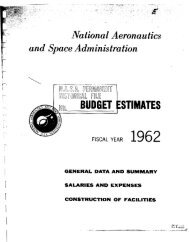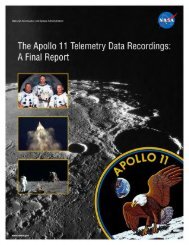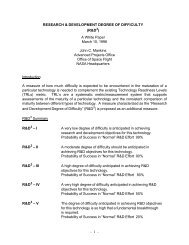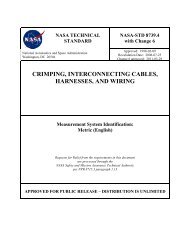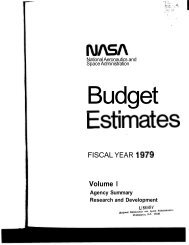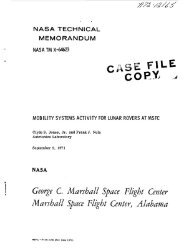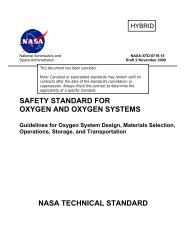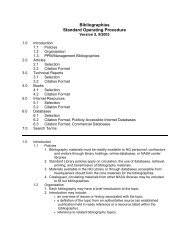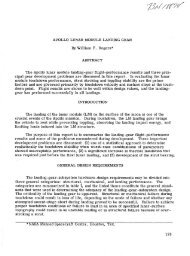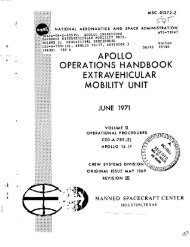- Page 2 and 3: TABLE OF CONTENTS FY 2001 CONGRESSI
- Page 4 and 5: NASA NASA Headquarters NASA Strateg
- Page 6 and 7: udget request for NASA for FY 2001
- Page 8 and 9: PLANS AND ACCOMPLISHMENTS HUMAN SPA
- Page 10 and 11: Space Shuttle The U.S. Space Shuttl
- Page 12 and 13: The Mars Global Surveyor entered Ma
- Page 14 and 15: are a number of individual satellit
- Page 16 and 17: initial national capability for dig
- Page 18 and 19: consolidated in FY 2000 to date, wi
- Page 20 and 21: FISCAL YEAR 1999 VA-HUD INDEPENDENT
- Page 22 and 23: NATIONAL AERONAUTICS AND SPACE ADMI
- Page 24 and 25: NATIONAL AERONAUTICS AND SPACE ADMI
- Page 27: NATIONAL AERONAUTICS AND SPACE ADMI
- Page 30 and 31: Human Space Flight, through the uti
- Page 32 and 33: NATIONAL AERONAUTICS AND SPACE ADMI
- Page 34 and 35: NATIONAL AERONAUTICS AND SPACE ADMI
- Page 38 and 39: Centrifuge Accommodation Module (CA
- Page 40 and 41: BASIS OF FY 2001 FUNDING REQUIREMEN
- Page 42 and 43: SCHEDULELkOUTPUTS Completed Increme
- Page 44 and 45: Flight 3A: 21 Truss Segment, Contro
- Page 46 and 47: Flight 7A. 1 Logistics and utilizat
- Page 48 and 49: Airlock Service And Performance Che
- Page 50 and 51: 0 Flight 2R, launches a Soyuz crew
- Page 52 and 53: BASIS OF FY 2001 FUNDING REQUIREMEN
- Page 54 and 55: Ground operations support provides
- Page 56 and 57: Conduct Increment Operations Review
- Page 58 and 59: utilizing a Spacehab Double Cargo M
- Page 60 and 61: additional international partners.
- Page 62 and 63: STRATEGY FOR ACHIEVING GOALS In 199
- Page 64 and 65: deployment of the U.S. Laboratory m
- Page 66 and 67: The AHST program activities merged
- Page 68 and 69: Actual: 2"" Qtr FY 1999 integrated
- Page 70 and 71: development integration template wa
- Page 72 and 73: The Microgravity Sciences Glovebox
- Page 74 and 75: BASIS OF FY 2001 FUNDING REQUIREMEN
- Page 76 and 77: enable deployment of six crew to or
- Page 78 and 79: ICM delivery to KSC for launch in r
- Page 80 and 81: 0 Phase 1 - Multiple contractors wi
- Page 82 and 83: NASA Tasks Avionics work would incl
- Page 84 and 85: GENERAL The Shuttle Operations prog
- Page 86 and 87:
implementation. The SFOC contractor
- Page 88 and 89:
BASIS OF FY 2001 FUNDING REQUIREMEN
- Page 90 and 91:
(2) (3) Stennis Space Center (SSC),
- Page 92 and 93:
Initiate Discovery (OV- 103) OMDP P
- Page 94 and 95:
SSME AHM Phase I1 Start Plan: 2'ld
- Page 96 and 97:
Start Repair of Pad A Flame Deflect
- Page 98 and 99:
The phasing strategy is coordinated
- Page 100 and 101:
eliability and safety margin and pr
- Page 102 and 103:
BASIS OF FY 2001 FUNDING REQUIREMEN
- Page 104 and 105:
Propulsion External Tanks are produ
- Page 106 and 107:
facilities including the MCC, ITF,
- Page 108 and 109:
ACCOMPLISHMENTS AND PLANS In FY 199
- Page 110 and 111:
enhancements identified through gro
- Page 112 and 113:
SDace Shuttle Main Engine (SSMEI Ad
- Page 114 and 115:
BASIS OF FY 2001 FUNDING REQUIREMEN
- Page 117 and 118:
BASIS OF FY 2001 FUNDING REQUIREMEN
- Page 119 and 120:
L Y c( v) 0 & Y 0 V 2 Y E u M I --
- Page 121:
SCHEDULES AND OUTPUTS Complete Pad
- Page 124 and 125:
PROGRAM GOALS There are several goa
- Page 126 and 127:
SCHEDULES AND OUTPUTS Missions SupB
- Page 128 and 129:
missions through funding integratio
- Page 130 and 131:
BASIS OF FY 2001 FUNDING REQUIREMEN
- Page 132 and 133:
BASIS OF FY 2001 FUNDING REQUIREMEN
- Page 134 and 135:
The NACC provides supercomputing ca
- Page 137 and 138:
HUMAN SPACE FLIGHT FISCAL YEAR 2001
- Page 139 and 140:
BASIS OF FY 2001 FUNDING REQUIREMEN
- Page 141 and 142:
BASIS OF FY 2001 FUNDING REQUIREMEN
- Page 143 and 144:
HUMAN SPACE FLIGHT FISCAL YEAR 2001
- Page 145 and 146:
BASIS OF FY 2001 FUNDING REQUIREMEN
- Page 147 and 148:
Advanced data acquisition and contr
- Page 149 and 150:
BASIS OF FY 2001 FUNDING REQUIREMEN
- Page 151 and 152:
BASIS OF FY 2001 FUNDING REQUIREMEN
- Page 153 and 154:
ACCOMPLISHMENTS AND PLANS During FY
- Page 155 and 156:
SCHEDULE AND OUTPUTS Laboratories &
- Page 157 and 158:
GOAL STATEMENT NATIONAL AERONAUTICS
- Page 159 and 160:
NATIONAL AERONAUTICS AND SPACE ADMI
- Page 161:
NATIONAL AERONAUTICS AND SPACE ADMI
- Page 164 and 165:
Distribution of Program Amount bv I
- Page 166 and 167:
the Discovery, Explorer and Support
- Page 168 and 169:
BASIS OF FY 2001 FUNDING REQUIREMEN
- Page 170 and 171:
BASIS OF FY 2001 FUNDING REQUIREMEN
- Page 172 and 173:
assembly of the Observatory using t
- Page 174 and 175:
planned work, astronauts discovered
- Page 176 and 177:
BASIS OF FY 2001 FUNDING REQUIREMEN
- Page 178 and 179:
ACCOMPLISHMENTS AND PLANS Gravity P
- Page 180 and 181:
Experiment (SEE), the Sounding of A
- Page 182 and 183:
NASA's Ames Research Center, Mounta
- Page 184 and 185:
BASIS OF FY 2001 FUNDING REQUIREMEN
- Page 186 and 187:
SCHEDULE & OUTPUTS Astro-E: Flight
- Page 188 and 189:
XMM Flight Model-2 RGS components w
- Page 190 and 191:
with the largest, Delta-class, movi
- Page 192 and 193:
spectrograph during its one-year mi
- Page 194 and 195:
Small-class Explorer Program WIRE L
- Page 196 and 197:
MAP, HESSI and GALEX missions conti
- Page 198 and 199:
scientific instruments. An optical
- Page 200 and 201:
Complete Imager Breadboard Plan: Se
- Page 202 and 203:
BASIS OF FY 2001 FUNDING REQUIREMEN
- Page 204 and 205:
2001 Mars Survevor Orbiter and Land
- Page 206 and 207:
BASIS OF FY 2001 FUNDING REQUIREMEN
- Page 208 and 209:
Galileo is executing a series of cl
- Page 210 and 211:
SNOE is a small scientific satellit
- Page 212 and 213:
BASIS OF FY 2001 FUNDING REQUIREMEN
- Page 214 and 215:
Space Science Technology provides f
- Page 216 and 217:
The technologies developed under th
- Page 218 and 219:
quieting systems, optical delay lin
- Page 220 and 221:
RESEARCH The Space Science Research
- Page 222 and 223:
Demonstrate scaleable computer for
- Page 224 and 225:
NRA Release Plan: 2'Id Qtr., FY 199
- Page 226 and 227:
TPF Technology Development Complete
- Page 228 and 229:
Complete Phase A and Transition to
- Page 230 and 231:
Research Program %ace Science Resea
- Page 232 and 233:
In High Performance Computing and C
- Page 234 and 235:
Focused Proprams The Astronomical S
- Page 236 and 237:
The ST-4/Champollion project was ca
- Page 238 and 239:
0 Gamma Ray Large Area Space Telesc
- Page 240 and 241:
Data Analysis NASA's Space Science
- Page 242:
BASIS OF FY 2001 FUNDING REQUIREMEN
- Page 246 and 247:
The Life and Microgravity Sciences
- Page 248 and 249:
SDace Product DeveloDment ISPDl 0 F
- Page 250 and 251:
A significant portion of the Bioast
- Page 252 and 253:
MEASURES OF PERFORMANCE The actual
- Page 254 and 255:
BASIS OF FY 20001 FUNDING REQUIREME
- Page 256 and 257:
FY 2000 will include final preparat
- Page 258 and 259:
MEASURES OF PERFORMANCE The actual
- Page 260 and 261:
Association, Case Western Reserve U
- Page 262 and 263:
In FY 200 1, MR funding will provid
- Page 264 and 265:
were identified for possible transi
- Page 266 and 267:
creation, use, transfer, ownership
- Page 268 and 269:
Protection Program: technical suppo
- Page 270 and 271:
MEASURES OF PERFORMANCE Crew Health
- Page 272 and 273:
BASIS OF FY 2001 FUNDING REQUIREMEN
- Page 274 and 275:
e a non-viable mission alternative
- Page 277 and 278:
NATIONAL AERONAUTICS AND SPACE ADMI
- Page 279 and 280:
SCIENCE, AERONAUTICS, AND TECHNOLOG
- Page 281 and 282:
OFFICE OF EARTH SCIENCE Major Devel
- Page 283 and 284:
EARTH SCIENCE ENTERPRISE PROGRAM GO
- Page 285 and 286:
products for these missions. These
- Page 287 and 288:
The challenges of Earth System Scie
- Page 289 and 290:
The QuikScat spacecraft was launche
- Page 291 and 292:
BASIS OF FY 2001 FUNDING REQUIREMEN
- Page 293 and 294:
design. Mission design includes suc
- Page 295 and 296:
61% LVS
- Page 297 and 298:
Critical Design Reviews - Confirms
- Page 299 and 300:
Jason- 1 Plan: March 1999 Actual: S
- Page 301 and 302:
ACCOMPLISHMENTS AND PROPOSED RESULT
- Page 303 and 304:
The Active Cavity Radiometer Irradi
- Page 305 and 306:
BASIS OF FY 2001 FUNDING REQUIREMEN
- Page 307 and 308:
The EDOS element of EOSDIS has been
- Page 309 and 310:
Some key indicators of DAAC perform
- Page 311 and 312:
In FY 2001, operations and completi
- Page 313 and 314:
BASIS OF FY 2001 FUNDING REQUIREMEN
- Page 315 and 316:
The second ESSP Announcement of Opp
- Page 317 and 318:
PICASSO-CENA Plan: Second Quarter,
- Page 319 and 320:
PROGRAM GOALS The goal of Research
- Page 321 and 322:
BASIS OF FY 2001 FUNDING REQUIREMEN
- Page 323 and 324:
The objectives of the mission scien
- Page 325 and 326:
the processes of the Earth system t
- Page 327 and 328:
We will continue the development of
- Page 329 and 330:
contributes a significant component
- Page 331 and 332:
Plans There is increasing evidence
- Page 333 and 334:
Accomplishments Fulfilling its Cong
- Page 335 and 336:
In FY 2001 ESE will provide continu
- Page 337 and 338:
Plans In FY 2000, we will continue
- Page 339 and 340:
Aperture Radar (SIR-C/X-SAR) data,
- Page 341 and 342:
BASIS OF FY 2001 FUNDING REQUIREMEN
- Page 343 and 344:
the Internet to link the schools to
- Page 345 and 346:
In FY 2000, we will continue to use
- Page 347 and 348:
capability and suitability of agric
- Page 349 and 350:
In FY 1999, CRSP established over 1
- Page 351 and 352:
BASIS OF FY 2001 FUNDING REQUIREMEN
- Page 353 and 354:
Advanced Technologv Initiative Incr
- Page 355 and 356:
ACCOMPLISHMENTS AND PROPOSED RESULT
- Page 357 and 358:
BASIS OF FY 2000 FUNDING REQUIREMEN
- Page 359 and 360:
BASIS OF FY 2001 FUNDING REQUIREMEN
- Page 361 and 362:
SCHEDULE AND OUTPUTS OPERATIONAL SP
- Page 363 and 364:
a 5 m 2 c a w a: 2 0 0 0 m .r( M a
- Page 365 and 366:
BASIS OF FY 2000 FUNDING REQUIREMEN
- Page 367:
BASIS OF FY 2000 FUNDING REOUIREMEN
- Page 370 and 371:
Pillar One: Global Civil Aviation G
- Page 372 and 373:
transports, utilize the nation's un
- Page 374 and 375:
BASIS OF FY 2001 FUNDING REQUIREMEN
- Page 376 and 377:
- The extensive breadth and depth o
- Page 378 and 379:
industry during their product devel
- Page 380 and 381:
Demonstrate 'smart' Active combusti
- Page 382 and 383:
Health and Usage Monitoring Systems
- Page 384 and 385:
from aircraft to space transportati
- Page 386 and 387:
advanced user interface capabilitie
- Page 388 and 389:
During FY 200 1, the effort to impr
- Page 390 and 391:
weather products included turbulenc
- Page 392 and 393:
Space Transfer and Launch Technolog
- Page 394 and 395:
Transportation Architecture studies
- Page 396 and 397:
BASIS OF FY 2001 FUNDING REQUIREMEN
- Page 398 and 399:
Aero-space technology .............
- Page 400 and 401:
Develop system software tools and t
- Page 402 and 403:
BASIS OF FY 2001 FUNDING REQUIREMEN
- Page 404 and 405:
conceptual design of full scale tec
- Page 406 and 407:
SCHEDULE AND OUTPUTS Enviornment Em
- Page 408 and 409:
BASIS OF FY 2001FUNDING REQUIREMENT
- Page 410 and 411:
educed by six decibels A-weighted (
- Page 412 and 413:
Civil Tiltrotor: Flight database of
- Page 414 and 415:
BASIS OF FY 2001 FUNDING REQUIREMEN
- Page 416 and 417:
Turbulence modeling and detection t
- Page 418 and 419:
SCHEDULE AND OUTPUTS Preliminary in
- Page 420 and 421:
ACCOMPLISHMENTS AND PLANS In FY 200
- Page 422 and 423:
eliable and environmentally compati
- Page 424 and 425:
Integration and Assessment: Complet
- Page 426 and 427:
BASIS OF FY 2001 FUNDING REQUIREMEN
- Page 428 and 429:
SATS Program products include: Simp
- Page 430 and 431:
BASIS OF FY 2001 FUNDING REQUIREMEN
- Page 432 and 433:
SCHEDULE AND OUTPUTS Demonstrate te
- Page 434 and 435:
BASIS OF FY 2001 FUNDING REQUIREMEN
- Page 436 and 437:
Launch Services (NGLS) acquisition
- Page 438 and 439:
E W Y 2 & c cd Y Ll-l 0 W s 2 p" i
- Page 440 and 441:
carrying out small-scale flight dem
- Page 442 and 443:
X-37 Roll out Plan: September 200 I
- Page 444 and 445:
FY 1999 FY 2000 m 2001 Integrated S
- Page 447 and 448:
SCIENCE. AERONAUTICS AND TECHNOLOGY
- Page 449 and 450:
STRATEGY FOR ACHIEVING GOALS Commer
- Page 451 and 452:
Technology Transfer Agents FY 1999
- Page 453 and 454:
In FY 2000, commercial partnerships
- Page 455:
(HQ) program offices provide additi
- Page 458 and 459:
PROGRAM GOALS The Mission Communica
- Page 460 and 461:
BASIS OF FY 2001 FUNDING REQUIREMEN
- Page 462 and 463:
more efficiency as it provides NASA
- Page 464 and 465:
switches, replacing old NASA-unique
- Page 466 and 467:
BASIS OF FY 2001 FUNDING REQUIREMEN
- Page 468 and 469:
The data processing function captur
- Page 470 and 471:
SCHEDULE AND OUTPUTS Number of NASA
- Page 472 and 473:
modern technology, commercial produ
- Page 474 and 475:
G4 0 E 0 cd a v) 0 Y 2 6 2 Y & 0 a
- Page 476 and 477:
The program goal is to provide reli
- Page 478 and 479:
BASIS OF FY 2001 FUNDING REQUIREMEN
- Page 480 and 481:
ACCOMPLISHMENTS AND PLANS The Space
- Page 482 and 483:
BASIS OF F Y 2001 FUNDING REQUIREME
- Page 484 and 485:
low-cost ground tracking capability
- Page 486 and 487:
capability is scheduled for late FY
- Page 488 and 489:
Ground Network Upgrades The Ground
- Page 490 and 491:
BASIS OF FY 2001 FUNDING REQUIREMEN
- Page 492 and 493:
BASIS OF FY 2001 FUNDING REQUIREMEN
- Page 494 and 495:
Autonomous Mission Operations This
- Page 496 and 497:
Ka-band Opto-electronic oscillator
- Page 498 and 499:
SCIENCE AERONAUTICS AND TECHNOLOGY
- Page 500 and 501:
NASA Implementation Plan for Educat
- Page 502 and 503:
- However, this is not the case in
- Page 504 and 505:
SCHEDULE & OUTPUTS In FY 99, 1,533,
- Page 506 and 507:
BASIS OF FY 2001 FUNDING REQUIREMEN
- Page 508 and 509:
BASIS OF' FY 2001 FUNDING REQUIREME
- Page 510 and 511:
Other measures of performance are i
- Page 513 and 514:
BASIS OF FY 2001 FUNDING REQUIREMEN
- Page 515 and 516:
ACCOMPLISHMENTS AND PROPOSED RESULT
- Page 517 and 518:
ACADEMIC PROGRAMS Historically Blac
- Page 519 and 520:
to the Federal mandates for MI’s,
- Page 521 and 522:
transition to achieving competitive
- Page 523 and 524:
SCHEDULE & OUTPUTS MUREP metrics ar
- Page 525 and 526:
developed or marketed. A major goal
- Page 527 and 528:
ACCOMPLISHMENTS AND PROPOSED RESULT
- Page 529 and 530:
working in NASA-related disciplines
- Page 531 and 532:
NASA Strategic Enterprises Involvem
- Page 533 and 534:
Although similar to the HBCU Progra
- Page 535 and 536:
U niversi tv IRA (Research): Califo
- Page 537 and 538:
GOAL STATEMENT NATIONAL AERONAUTICS
- Page 539 and 540:
NATIONAL AERONAUTICS AND SPACE ADMI
- Page 541:
NATIONAL AERONAUTICS AND SPACE ADMI
- Page 544 and 545:
GENERAL The Safety, Mission Assuran
- Page 546 and 547:
continue, and about 10 programmatic
- Page 548 and 549:
PROGRAM GOALS The Space Communicati
- Page 550 and 551:
BASIS OF FY 2001 FUNDING REQUIREMEN
- Page 552 and 553:
The initiation of the ISS assembly
- Page 554 and 555:
In FY 2000, all integration activit
- Page 556 and 557:
Command, telemetry, and voice syste
- Page 559 and 560:
PROGRAM GOALS MISSION SUPPORT FY 20
- Page 561 and 562:
. Other Than Full-Time Permanent Po
- Page 563 and 564:
(I) N 0 0- / /
- Page 565 and 566:
I. Personnel and related costs A. C
- Page 567 and 568:
JOI1NSON SI’ACE CE:NlfCfi KENNEDY
- Page 569 and 570:
DISTRIBUTION OF FULL-TIME EQUIVALEN
- Page 571 and 572:
knowledge necessary to predict radi
- Page 573 and 574:
RESEARCH AND PROGRAM MANAGEMENT FIS
- Page 575 and 576:
RESEARCH AND PROGRAM MANAGEMENT FIS
- Page 577 and 578:
CENTER MANAGEMENT AND OPERATIONS -
- Page 579 and 580:
RSEARCH AND PROGRAM MANAGEMENT FISC
- Page 581 and 582:
RESEARCH AND PROGRAM MANAGEMENT FIS
- Page 583 and 584:
DISTRIBUTION OF FULL-TIME EQUIVALEN
- Page 585 and 586:
Biological Research Project, the ke
- Page 587 and 588:
RESEARCH AND PROGRAM MANAGEMENT FIS
- Page 589 and 590:
RESEARCH AND PROGRAM MANAGEMENT FIS
- Page 591 and 592:
CENTER MANAGEMENT AND OPERATIONS -
- Page 593 and 594:
RESEARCH AND PROGRAM MANAGEMENT FIS
- Page 595 and 596:
SPACE SCIENCE Research and Technolo
- Page 597 and 598:
PROGRAM OPERATIONS Corporate Operat
- Page 599 and 600:
Average GS/GM grade Average ES sala
- Page 601:
LANGLEY RESEARCH CENTER - The Langl
- Page 604 and 605:
The Construction of Facilities (CoF
- Page 606 and 607:
INSTALLATION AND PROJECT HUMAN SPAC
- Page 608 and 609:
CONSTRUCTION OF FACILITIES FISCAL Y
- Page 610 and 611:
Space Flight Operations [Space Shut
- Page 612 and 613:
PROJECT TITLE: Repair and Upgrade S
- Page 614 and 615:
PROJECT TITLE: Construct Laboratorv
- Page 616 and 617:
The BAF will benefit the Internatio
- Page 618 and 619:
PROJECT TITLE: Rocket-Based Combine
- Page 620 and 621:
Mission SuDDort Discrete Proiects:
- Page 622 and 623:
PROJECT TITLE: Provide 34.5 kV Alte
- Page 624 and 625:
PROJECT TITLE: Repair Sanitarv Sewe
- Page 626 and 627:
PROJECT TITLE: Restore Chilled Wate
- Page 628 and 629:
PROJECT TITLE: mgrade 34-Meter Beam
- Page 630 and 631:
PROJECT TITLE: Construct Operations
- Page 632:
PROJECT TITLE: Construct ODerations
- Page 635 and 636:
PROJECT TITLE: ReDairs to Electrica
- Page 637 and 638:
PROJECT TITLE: Replace Roof, Buildi
- Page 639 and 640:
PROJECT TITLE: Repair Storm Drainag
- Page 641 and 642:
consistent with current and anticip
- Page 643 and 644:
C. Glenn Research Center (GRCl 1. R
- Page 645 and 646:
13. Install Pier Scour Protection,
- Page 647 and 648:
3. Facilities Utilization Analyses
- Page 649 and 650:
PROJECT TITLE: Environmental ComDli
- Page 651 and 652:
ENVIRONMENTAL ACTIVITIES COST ESTIM
- Page 653 and 654:
OFFICE OF INSPECTOR GENERAL INSPECT
- Page 655 and 656:
using a structured approach encompa
- Page 657 and 658:
SCHEDULE & OUTPUTS WORKLOAD Investi
- Page 659 and 660:
TRAVEL FY 1999 FY 2000 IT 2001 (Tho
- Page 661 and 662:
NATIONAL AERONAUTICS AND SPACE ADMI
- Page 663 and 664:
Space Science Chandra Development G
- Page 665:
NATIONAL AERONAUTICS AND SPACE ADMI
- Page 668 and 669:
NATIONAL AERONAUTICS AND SPACE ADMI
- Page 670 and 671:
During 1995, Federal accounting sta
- Page 672 and 673:
NATIONAL AERONAUTICS AND SPACE ADMI
- Page 674 and 675:
X-33 Advanced Technology Demonstrat
- Page 676 and 677:
SuDer LiPhtweight Tank The objectiv
- Page 678 and 679:
TDRS Redenishment SDacecraft Promam
- Page 680 and 681:
Space Infrared Teh%CODe Facility (S
- Page 682 and 683:
Stratospheric Observatory for Infra
- Page 684 and 685:
The Explorer Promam The Explorer pr
- Page 686 and 687:
Microwave Anisotropy Probe Developm
- Page 688 and 689:
Mars Global Sumevor This mission wi
- Page 690 and 691:
Discoverv Missions Discovery missio
- Page 692 and 693:
Stardust The Stardust mission was s
- Page 694 and 695:
Comet Nucleus Tour KONTOUR) In Octo
- Page 696 and 697:
Deer, Space 1 Deep Space 1 was sele
- Page 698 and 699:
Earth Observing System Before the E
- Page 700 and 701:
(Budget Authority in Millions of Do
- Page 702 and 703:
The Earth Probes program Is the com
- Page 704 and 705:
TroDicd Rainfall Measuring Mission
- Page 706 and 707:
The budgetary estimates provided be
- Page 708 and 709:
In ternational SDace Station (Budge
- Page 710 and 711:
I. Personnel and related costs A. C
- Page 712 and 713:
JOI INSON Sf’A(‘f< (‘fNII
- Page 714 and 715:
DISTRIBUTION OF FULL-TIME EQUIVALEN
- Page 716 and 717:
DISTRIBUTION OF FULL-TIME EQUIVALEN
- Page 718 and 719:
DISTRIBUTION OF FULL-TIME EQUIVALEN
- Page 720 and 721:
DISTRIBUTION OF FULL-TIME EQUIVALEN
- Page 722 and 723:
DISTRIBUTION OF FULL-TIME EQUIVALEN
- Page 724 and 725:
PROGRAM OPERATIONS Corporate Operat
- Page 726 and 727:
2 Q) 4 F! M E 13 \ d E cd c. 2 rn w
- Page 728 and 729:
LANGLEY RESEARCH CENTER - The Langl
- Page 730 and 731:
........................ FTE Summar
- Page 732 and 733:
JOHN H. GLENN RESEARCH CENTER at LE
- Page 734 and 735:
HEADQUARTERS I FTE: I INSPECTOR Fy
- Page 736 and 737:
...................................
- Page 738 and 739:
; . ....... .......... FTE Summary
- Page 740 and 741:
- OBJECT CLASSIFICATION (FY 2001 CO
- Page 742 and 743:
OBJECT CLASSIFICATION (FY 2001 CONG
- Page 744 and 745:
OBJECT CLASSIFICATION (FY 2001 CONG
- Page 746 and 747:
OBJECT CLASSIFICATION (FY 2001 CONG
- Page 748 and 749:
OBJECT CLASSIFICATION (FY 2001 CONG
- Page 750 and 751:
. * . DIRECT 0- 11 PERSONNEL C’0h
- Page 752 and 753:
INTEGRATED SPACE TRANSPORTATION PRO
- Page 754 and 755:
- FY 1999 0- T op Plan 1413.8 EOS 6
- Page 756 and 757:
FY 2001 EARTH SCIENCE CROSSWALK PRO
- Page 758 and 759:
Technology Advanced Space Transport
- Page 760 and 761:
FY 200 1 PRES BUDGET Aero-Space Tec
- Page 762 and 763:
FY 1999 Budget Crosswalk (Thousands
- Page 764 and 765:
FY 2001 Budget Crosswalk (Thousands
- Page 766 and 767:
FY 1999 Budget Crosswalk (Thousands
- Page 768 and 769:
FY 2001 Budget Crosswalk (Thousands
- Page 770 and 771:
FY 1999 Budget Crosswalk (Thousands
- Page 772 and 773:
FY 2001 Budget Crosswalk (Thousands
- Page 775 and 776:
NASA FY 2001 Performance Plan Backg
- Page 777 and 778:
Outcomes of NASA’s Activities Gov
- Page 779 and 780:
management, the budget for the Miss
- Page 781 and 782:
The Performance Evaluation Process
- Page 783:
inadvisable to incentivize on-time
- Page 786 and 787:
Goal: Chart the evolution of the un
- Page 788 and 789:
Internal Assessment The Space Scien
- Page 790 and 791:
Strategic Plan Goal Contribute meas
- Page 792 and 793:
SSE FYO1 ~~~~ Performance Target So
- Page 795 and 796:
Earth Science Enterprise Mission Th
- Page 797 and 798:
Performance Measures Goal: Expand s
- Page 799 and 800:
Objective: Detect long-term climate
- Page 801 and 802:
Goal: Enable the productive use of
- Page 803 and 804:
Internal Assessment The Earth Scien
- Page 805 and 806:
Strategic Plan productive use of ES
- Page 807 and 808:
ESE FYO1 Performance Target Success
- Page 809 and 810:
Human Exploration and Development o
- Page 811 and 812:
Goal: Expand Scientific Knowledge.
- Page 813 and 814:
0 Target: The ISS program has under
- Page 815 and 816:
Cross-cutting target 0 Target: Impr
- Page 817 and 818:
Strategic Plan Goal Soal: Expand %!
- Page 819 and 820:
Strategic Plan Goal Enable and esta
- Page 821 and 822:
i; - Budget Category %ace Station S
- Page 823:
HEDS FYO1 Performance Target 1H21:
- Page 826 and 827:
Global Civil Aviation Goal - Develo
- Page 828 and 829:
Research and Development Services G
- Page 830 and 831:
itrategic Plan i0al levolutionary '
- Page 832 and 833:
Awamn System Capacit Anlauon Safety
- Page 834 and 835:
The percentage of awards to small a
- Page 836 and 837:
I Strategic Plan Obiective Ensure t
- Page 839 and 840:
Provide Aerospace Products and Capa
- Page 841 and 842:
arateeic Plan Goal Enable NASA's St
- Page 843 and 844:
Generate Knowledge Goals NASA provi
- Page 845 and 846:
Objective: Archive data and publish
- Page 847:
I Generate Knowledge FYO1 Performan
- Page 850 and 851:
Increase the opportunities for tran
- Page 852 and 853:
Convey information about, and knowl
- Page 855 and 856:
Space Science Enterprise Performanc
- Page 857 and 858:
Target 1%: Obtain expected scientif
- Page 859 and 860:
Target 158: Perform innovative scie
- Page 861 and 862:
Target 1512: Plan, develop, and val
- Page 863 and 864:
Target 1Y4: Explain the dynamics of
- Page 865 and 866:
0 Develop a comprehensive climatolo
- Page 867 and 868:
0 Develop experimental models to de
- Page 869 and 870:
Human Exploration and Development o
- Page 871 and 872:
0 0 Target: lH11: Successfully comp
- Page 873 and 874:
0 0 0 0 Target: 1H21: Achieve at le
- Page 875 and 876:
Aero-Space Technology Enterprise Pe
- Page 877 and 878:
Target 1R7: Complete the Advanced G
- Page 879 and 880:
Aero-Space Base R&T Complete assess
- Page 881 and 882:
Maintain a diverse NASA workforce w
- Page 883 and 884:
0 Dedicate 10 to 20 percent of the
- Page 885 and 886:
Communicate Knowledge Performance T



